PC
T&P
| |
PERSONAL CONSTRUCT
THEORY & PRACTICE
|
Vol.4 2007 |
| PDF version |
| Author |
| Reference |
| Journal Main |
| Contents Vol 4 |
| Impressum |
| DOING
PSYCHOLOGY THAT COUNTS: GEORGE KELLY'S INFLUENCE |
||||
| David V. Canter |
||||
| The School of Psychology, University of Liverpool, UK |
||||
| ORIGINS IN THE 1960’S It was in the final year of my undergraduate degree, in 1964, that I was introduced to the subversive ideas of George Kelly. This was the era of the Beatles and the Cuban missile crisis that we can now see, with the benefit of hindsight, as the flowering of optimistic challenges to the old order that had been cleared away by the Second World War. In my undergraduate days support for Nuclear Disarmament went hand in hand with the view that laboratory based studies of people, particularly of the limited sample, of about 8% of the population, who were undergraduate students at the time, was totally artificial. There was a stream of thought, to which I still subscribe, that psychologists needed to get out into the streets and see how people actually made sense of their lives, when not asked to press buttons in response to flashing lights. Part of this perspective was given impetus when I was introduced to the two Biblical-like volumes of Kelly’s magnum opus. Kelly’s elementary, but profound, claim that we needed to understand an individual’s ways of conceptualising the world in his/her own constructs, was a wonderful antidote to lingering Skinnerian behaviourism that was the orthodoxy in those days. The methodology he developed that captured a visual image of the structure of those constructs was one of the most exciting discoveries I made in my psychological training. I had already been exposed to factor analysis and to Osgood’s ‘semantic differential’, but the application of the notion of a construct space to the mental world of an individual has had a profound influence on all my thinking and been of immeasurable value to many of the applications of psychology in which I have been involved. The excitement of PCP was given further charge by intermittent contact with George Kelly’s representative on earth, Don Bannister. His highly subversive campaign against the traditions of British psychology and, as he put it, its ‘hardening of the categories’ by limiting what was regarded as acceptable psychology is, sadly, even more pertinent today as the oligarchy that manages the Research Assessment Exercise is still defining what is good or bad psychology in very narrow terms. The PCP viewpoint enables us to understand how locked in their own construct systems so many senior psychologists are, but our acceptance that they have a distinct world view does not mean that we need to accept their viewpoint. The value of the central notion of a ‘construct system’ has even spread out to my interest in musical composition. It helps me to understand that I, or any other composer, have a framework of constructs that are unravelled and given shape during the composing process. The interaction with the musical score helps to polish and shape those constructs, which will often be non-verbal. CONSTRUCTS WITHOUT TEARS: THE MULTIPLE SORTING TASK The great achievement of PCP is to have a rich theoretical framework closely tied into a fertile methodology. I have always been impressed by how the theory and methodology of PCP are so well integrated that it is difficult to tell which is the dominant partner. I have tried to emulate this in my own work. But there have always been two aspects of the methodology with which I am uncomfortable. One is the insistence on always determining both poles of a bi-polar construct. Indeed, even the claim that all constructs are implicitly bi-polar seems to me an empirical issue rather than an axiomatic one. There do appear to be important contexts in which bi-polarity is not the dominant part of the construct system. Ways of conceptualising colours may be one good example, where the four way split of red, yellow, blue and green seems to have more empirical support. Reducing each of these dominant hues to a distinct construct still raises questions about what its opposite is. Although we are dealing with physical attributes here I think there are many psychological constructs that do not have a comfortable opposite pole, most notably when activities are being construed in terms of their dominant purpose, such as preparation, recreation, or study. The second discomfort I have is with the ponderous, time-consuming quality of the fully orthodox Repertory Grid. As many researchers have found the initial construct elicitation process is often the most powerful part of the whole process. That is where the dominant aspects of the individual’s perspective become apparent. These two criticisms of the repertory grid led me to work with my PhD students in the 1970’s (Canter, Brown & Richardson, 1976) to develop a procedure that was really an elaboration of the triadic construct elicitation procedure, which was eventually published under the label of the Multiple Sorting Task (MST) by Canter, Brown, &Groat (1985). The MST consists of asking people to sort elements into as many groups as they like with as many elements in each group as they like and then to describe the basis of their categorisation scheme. Once the first sort is completed, we may ask them to have another go to see if they can come up with a different classification scheme. We can also ask them to sort the elements into a ‘forced’ sort in which we give them the dominant construct, such as preference or solvability. One of the reasons for the decade long gap between our first development of the approach and its eventual publication was that it turned out to be remarkably to difficult to work out how to maintain the idiosyncratic qualities of the initial sortings and still produce some coherent summary of the data. Any creation of an association matrix, in which the frequency with which items are assigned to similar categories are counted, hides the differences between individuals. Eventually we found that a rather unusual multi-dimensional scaling procedure, known as Multidimensional Scalogram Analysis (MSA) developed by Lingoes and Guttman in the 1960’s (Lingoes, 1973) allowed us to represent the elements being sorted as a spatial configuration, across a whole set of sorts, whilst also allowing us to see clearly the ways in which different individual sorts contributed to the overall configuration. We could do this for a number of sorts for one individual or by taking a group of sortings from a number of individuals. The individual and ‘group grid’ is therefore possible to generate without the need for anyone in the group to use the same constructs as anyone else. We later realised that in a sense we are exploring a group decision making process about the categorisation of the elements, and did eventually set up studies to explore directly how this approach could facilitate group discussions (Wilson & Canter, 1993). This paper with my colleague Margaret Wilson is therefore a particularly full introduction to the whole approach. We have found the MST to be very powerful in a great range of different applications, and I have supervised at least half a dozen PhD’s built around this methodology. We have applied it to topics as varied as exploring the nature of hostels available for alcoholics, the differences between transvestites and transsexuals in their conceptualization of gender, the way people construe their living rooms, a senior management team’s understanding of all the team members and their role in the organization, and other examples to which I shall now turn. ARCHITECTURE AS A CONSTRUCT SYSTEM One particularly interesting application of the sorting procedure is its use as a tool for designing buildings. This application is based on the notion that buildings reflect the construct system of their designers and that in many cases the more fully the designer can draw upon the conceptualisations of the users the more effective the building will be. I have applied this approach to the briefing of architects in major design projects, such as the design of a Casino, an engineering centre for a car and bus manufacturer (described in Canter, 1982) and a design centre for a petrochemical manufacturer (Canter & Scott, 1996). These were large, complex projects, but one in which the conceptualisation of the users is most clearly reflected in the redesign of a ward for a psychogeriatric population in need of constant medical care (Canter & Scott, 1996). It was the construct system of the nurses and other professionals who worked on this ward that was taken as the basis for conceptualising what the redesign should accommodate. Figure 1 (drawn from page 249 of Canter & King, 1996) shows the list of activities that the ward accommodates, developed from interviews with all the professionals involved in the ward. |
||||
List of 40 activities used in activity sorting
Figure 1: List of activities used for the sorting task in the ward redesign project These 40 activities were then sorted by many different members of staff and their sortings summarised using MSA (as described in Canter et al, 1985). The resulting configuration is given in Figure 2 below. 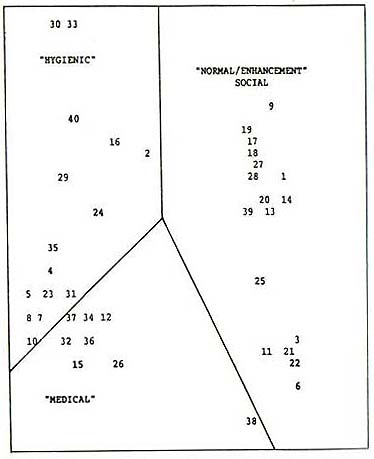 Figure 2: MSA results for the sorting of 40 ward activities by 15 ward staff This figure shows that the nurses made a clear distinction between three groups of activities. One to the right of the plot is all those activities that are regarded as ‘normal’ by the staff and therefore of therapeutic value as enhancing the daily experience of the patients. It is noteworthy that at the bottom of this region are activities that involve contact with professionals not normally based on the ward such as the doctor, chaplain and occupational therapists. This contrasts with the activities at the top of the region which involves contact with other patients and visits from relatives. To the left of the plot are activities that have a much stronger professional emphasis, These are distinguished at the top into activities that only involve the staff and not the patients, such as laundry duty, and those that involve direct contact with the patients in a professional capacity. Similar sortings were also carried out on the actual patients, which revealed the dominant construct of how much care the patients needed. In addition a ‘spatial sorting’, was carried out, which had been developed by Arie Peled to reveal the way that people saw the actual spatial relationships, in the abstract, between the activities (Peled, 1976). The results of these various analyses were combined. They led to the identification of a number of distinct types of place: areas for patients on their own, areas for specific sub-sets of essentially group activities, such as physiotherapy, and a central functional area in which the nurses are involved closely with the patients, as shown in Figure 3. 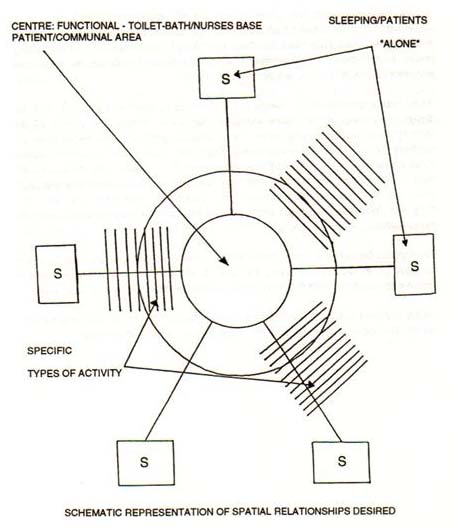 Figure 3: Schematic representation of the main types of place needed and their general spatial relationships for the Ward redesign project. This schematic representation was enriched in the design proposal with information about the constructs that characterised the different locations, including the need to house patients needing different levels of care. The whole framework was then used to consider the existing building and how it might be modified to accommodate the emergent conceptual structure. This gave rise to a detailed proposal for the redesign that everyone involved was very excited about. As so often happens with innovative design projects other forces were at play whilst we were doing this commissioned work. They decided the whole hospital sight should be abandoned and so it was sold off to become accommodation for an orthodox religious community. PRODUCT MAPS AND MARKET GAPS The representation of a construct system of activities as an actual set of spaces in a building has parallels with the representation of elements as entities within a conceptual space. If this conceptual space is regarded as a domain of products then gaps within this space could be taken as opportunities within the market place for new products. I have been involved in a number of commercial studies that do look directly for the metaphorical ‘gaps in the market’ by seeing where the holes are in consumers’ conceptual systems. The clearest and most successful application of this approach was in a study of the biscuit and confectionary market. The practical advantage of studying biscuits is that the MST can be conducted with participants sorting the actual products. We have also been able to take the individual sorting a step further, following up the idea that we are dealing with a group decision making process, and give the group the MSA ‘map’ with the biscuits on it. This map is then used as a basis for a ‘focus group’ discussion, thereby combining the individual constructs with the benefits that accrue from exploring the structure of these constructs in a group. Figure 4 shows the MSA output for the sorting of 47 different biscuits and confectionary. As with Figure 2 above, the closer together any two elements are the more likely they are to be assigned to the same category by the respondents. This particular figure is based on results from 32 respondents. 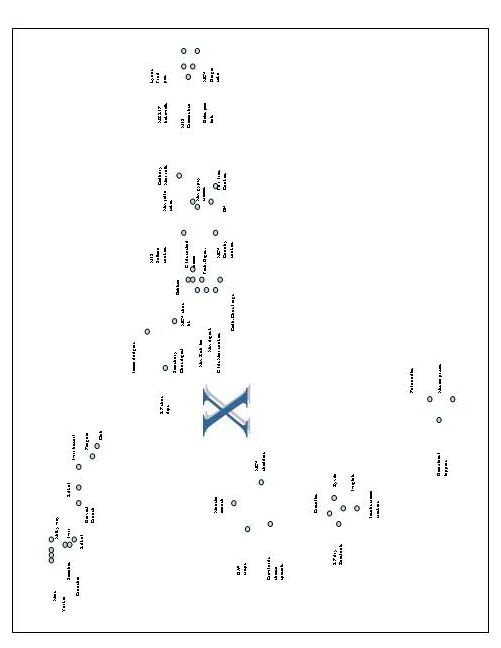 Figure 4: MSA derived from the free sorting of 47 biscuits by 32 respondents. X indicates a major new product opportunity (turn clockwise) The details in Figure 4 are not as important as the overall structure. This shows a clear distinction between the confectionary in the region at the top right, running from Jamie Dodgers to Lyons Fruit Pies, and that biscuits that are at lower left of the plot, running in a diagonal from Crawfords Cheese Specials to Jacobs Cream Crackers. Thus although there are many marketing details that can be drawn from Figure 4, especially when market share is incorporated, this broad division between the savouries and the sweet biscuits that comes close around the Cheese Specials and the Jamie Dodgers, is of particular interest. It suggests that consumers make a big distinction between savoury and sweet biscuits. But the gap where these two regions meet indicates that there is the possibility that the distinction is not as total as may have been anticipated. In other words, the gap in the centre of the plot suggests the possibility of a product that draws on some of the qualities of the savouries and also some of the qualities of the sweet products. The discussion with respondents made clear that the savouries were generally regarded as good and wholesome but not very interesting, whereas the sweets were enjoyable but rather naughty. It was therefore proposed therefore that there was room in the market place for a ‘wholesome sweet biscuit’ defined by the region marked with an X on Figure 4. Thus the Hobnob was born. It turned out to be unusual in that most new products quickly fade away. But although this study was done over two decades ago the brand is still going strong. CONCEPTUALISING CRIME SCENES The mapping of construct systems with activities and confectionary has an aspect to it that is not often emphasised in the PCP literature, although fundamental to Kelly’s ideas. This is the assumption that the construct system is the basis for action. Most obviously in the case of biscuits the action is the actual purchase of products. However, there are situations in which the construct system has even stronger life and death implications, by being the basis of crucial decisions that can affect many lives. The conceptualisation of possibilities opens the way to action in the context of demanding decision making. One area in which this is of especial interest is in the decision making of those Senior Investigating Officers who lead homicide investigations. This area is of interest for many reasons, but I will mention just a couple. One is that this exceptionally important activity, which fills TV and published fiction and is so often a dominant part of the news, has been very little explored. Another is that the emergence of Investigative Psychology (cf. Canter & Young, 2003) was based on the idea that ‘Offender Profiles’ could be given to investigating officers to characterise an unknown offender. Yet how these ‘profiles’ might integrate with construct systems of detectives was never explored. A PhD student of mine, Michelle Wright, has therefore been exploring the construct systems of investigating officers. Once again the MST has been the basis of her explorations, but this time she is using photographs of murder scenes, with brief descriptions of the scene as shown in Figure 5. 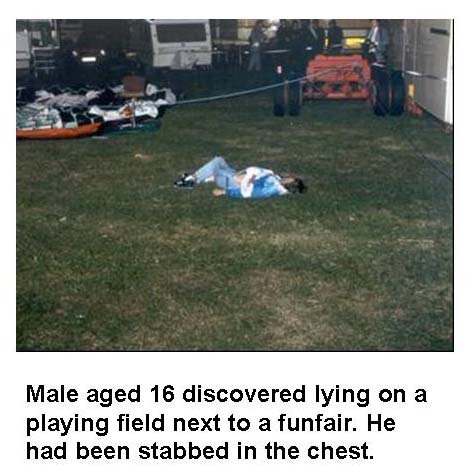 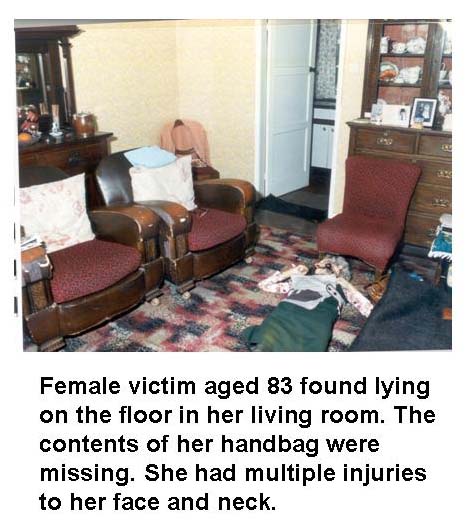 Figure 5: Examples of two crime scene photographs used in the MST by Senior Investigating Officers. A variety of experienced and less experienced police officers sort these pictures into groups in accord with their understanding of the nature of the murder. This is used as the basis of an interview about how they approach the task of murder investigation. It is interesting that these detectives see the task of sorting the crime scenes, and describing their categorisations, as a valid representation of the task they face when got out of bed to go and take charge of an investigation. It is also worth recording that they are very willing to develop quite detailed ideas of what went on and gave rise to the crime from this somewhat limited information. In other words, it is clear from this study that the business of developing ‘profiles’ of an offender is not unique to the FBI or people schooled in any particular tradition. It is rather an integral aspect of being an informed, experienced investigator. From this perspective, then, Criminal Offender Profiling, Crime Scene Analysis, Psychological Profiling and all the other terms that are used to indicate the drawing of inferences about an offender from the way a crime is committed, are no more or less than the articulation of a construct system for conceptualising how offences may differ from each other and the implications those differences have. What we need to know is the structure of this construct system; what the dominant themes, or latent meanings, are within it. By knowing the cognitive structure we can then see how that can be enriched by insights from empirical psychology. The MSA results given in Figure 6 from the first small sample of detectives are thus a helpful step forward. 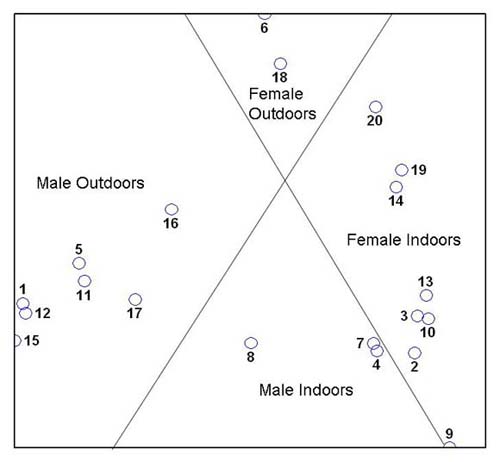 Figure 6: MSA of 20 crime scene photographs sorted by Senior Investigating Officers This spatial representation of the overall construct systems of detectives is particularly interesting because it is possible to determine a very simple underlying structure to the conceptualisations. These latent meanings are indicated by lines drawn on the plot. They show that the crime scenes can be divided up on the basis of two basic (and yes I have to admit) bi-polar constructs. They relate to whether the victim is male or female, and whether the location is indoors or outdoors. From these two constructs a wealth of possibilities are drawn by these investigating officers of what might have happened in the crime. From these assumed criminal events the officers then develop ideas about who the likely culprit is and how s/he may be found. Of particular theoretical importance here is that these constructs are taken as the basis for an assumed narrative. They are given life by hypotheses about possible protagonists and the series of unfolding events in which they are engaged. So, for example a woman found dead indoors will initially be considered as the victim of a domestic row between people who have a long-standing relationship. On the other hand a man found outdoors will set in motion early speculations about brawls between men, whereas women outdoors and men indoors will be thought of as victims of some other crime that has given rise to murder. PERSONAL NARRATIVES OF CRIMINALS The idea that constructs imply narratives is one that I have been particularly interested in over the past few years. PCP is all too often a static consideration of an individual at a point in time, a cross-section through their unfolding life. Yet Kelly shares with Skinner the view of people as active organisms; agents taking part in the world and modifying their construct systems as a consequence. But this dynamic change over time is not very often given emphasis in the personal construct studies of which I am aware. I have therefore been trying for some time to get to grips with how people embed themselves in an unfolding narrative. The first exploration of this was in my book Criminal Shadows (Canter, 1995), in which I considered the implicit narratives that serial killers and rapists reveal within their crimes. More recently I have tried to get to their conceptualisations more directly (Canter, Kaouri & Ioannou, 2003). I have done this by arguing that the emotions involved in a crime when taken together with the role they assign to themselves during the crime implies their involvement in a personal narrative that gives dynamism and significance to their crimes. Questionnaires completed by criminals describing how they felt and whether they thought of themselves, for instance, as a victim or hero at the time allow us to explore whether there are a set of distinct storylines that they may be drawing on. These stories imply other key players and significant constructs, but for the moment we are working at the higher level of identifying the dominant themes in their criminal activity. Earlier work on emotions (Canter & Ioannou, 2004) did show some interesting results, but when combined with a questionnaire about the roles the results, as shown in Figure 7, are even clearer. The analysis in Figure 7 is a Smallest Space Analysis. This represents the rank order of the inverse of the correlations between any two questions as the rank order of the distances between those questions as represented as points on the configuration (cf Canter, 1983, or Shye, Elizur & Hoffman, 1994). The regions are interpreted from the common meanings of items within them, much factors are interpreted from the loadings of variables on the factors. In Figure 7 four distinct regions can be readily discerned. At the top the items of feeling thoughtful and calm are interspersed with the roles of a professional who was just doing a job of work. To the right of this is a region characterised by feeling lonely and helpless like a victim. Below this are terms that imply the narrative of revenge coming out of being worried and angry. The fourth group has the offender feeling excited about taking risks as part of an adventure. These four implicit narratives are particularly interesting because they have parallels to the four canonical narratives identified by Frye (1957) as the basis of all stories, as outlined by Canter et al (2003). This helps us to build bridges between PCP and the dominant narratives of our culture. Although constructs are personal, it has never been denied that they emerge from a social context. They must be given life by the way they are rooted in the unfolding storylines that characterise any society. A PCP APPROACH TO M.O. The link between constructs and actions does seem to me to be a very important one that is too often neglected. It suggests to me, also, that it makes sense to explore what I like to think of as implicit or non-verbal construct systems. These are the patterns of actions that a person performs in particular sorts of situations. So just as we can produce a map like representation of an individual’s cognitive structure, derived from a repertory grid or an MST, so we can see the non-verbal structure of that person’s actions if we have enough information of what they do in a variety of situations. The notion of modus operandi (m.o.) is not a very clear one, but in general suggests a pattern of behaviour that is characteristic of an individual (Canter & Youngs, 2003). In popular thought it is seen as a distinct ‘signature’ of the offender that is more or less unique to a particular person. In fact it is as rare for any criminal to have a unique and distinct way of committing a crime as it is for anyone else to have a unique and distinct way of doing anything, whether it is as banal as having breakfast or as heavily significant as giving a lecture. There will be aspects of what a person does on different situations that are reasonably consistent and possibly crucial to the way s/he acts and other actions that they carry out on some occasions but not on others. If this pattern of actions is thought of as an implicit system, akin to and growing out of their construct system, then it makes sense to model their actions in much the same way as we model a personal construct system. We take a set of actions that the person carries out across a range of similar situations. Those actions that most frequently co-occur we show as being highly related and those that are less likely to co-occur we show as distinct from each other. This gives us a pattern of actions arranged in terms of their degrees of co-occurrence. We have found this possible to do and instructive to look at for criminals, in particular burglars. Figure 8 shows two separate SSA analyses for two different serial burglars. In effect this is a way of representing each burglar’s m.o. as if it were a construct system of actions. 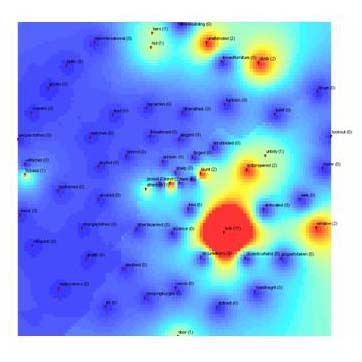 Figure 8-1 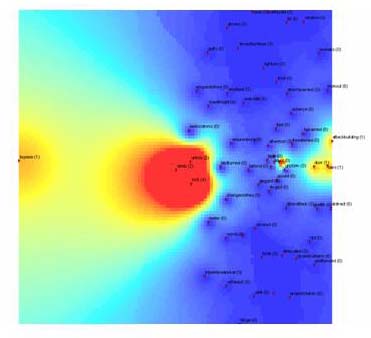 Figure 8-2 Figure 8: SSA’s of two different offenders who have each committed 15 burglaries. The points are action and the coloured regions indicate the frequency of those actions across the crimes, with red the most frequent and blue the least In a variety of studies (reviewed in Canter & Youngs, 2003) we have found that the frequency of any action contributes to our understanding of the structure of those actions. Therefore in Figure 8 frequency contours have been turned into coloured regions. They thus show interesting differences between the patterns of actions of these two offenders. The offender on the left reveals a number of distinct foci to his activities. He is a man of many roles who seems to select his actions for the crime in question. He may climb into the building, or force the lock. He may prepare his getaway in some cases but not in others. This contrasts with the offender on the right who has a very distinct m.o. He typically climbs into the building and is untidy in his search. We do not know as yet how these different behavioural structures relate to the experiences of the offender or even the sort of offender he thinks he is. Such a combination of data is extremely difficult to obtain because the different aspects of it are archived in very different places under the control of different institutions with different access hurdles. But at least we are opening up a productive way of dealing with the slippery concept of modus operandi and showing how it may be related to more precise ideas of construct systems and personal narratives. FACET THEORY Hopefully those who have read this far will have accepted that the work described is powerfully influenced by Kelly’s theory. They may therefore be surprised that the many works cited so rarely make a clear cross-reference to the PCP literature. This is a weakness of those publications but there is an explanation, if not an excuse. The methodologies on which I have drawn are derived very strongly from the work of Louis Guttman and his Facet Theory (cf. Canter, 1983, 1985, Shye et al, 1994). This is a theory about how science works rather than about human beings as such, but it is an approach to science that is remarkably compatible with PCP, being fundamentally alternative constructivist. 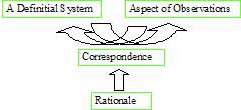 Figure 9: Components of a theory (Guttman) In summary as shown in the diagram of Figure 9, Guttman’s facet approach enshrines the idea that there are four components to any theory. A framework for describing the key concepts of the theory and their relationships to each other, which Guttman calls ‘a definitional system’ but which we could recognise as the scientist’s construct system. There are, secondly, a set of observations, some aspect of which are taken as being of significance for the theory. So here again we have the representation of the construct system within the empirical observations. Thirdly, any theory requires some proposal of what aspects of the construct system should correspond to the empirical observations. In Guttman’s terms this correspondence is usually taken to be features of the regional structures in the MDS analyses that are carried out on the data. He always emphasised as well that the correspondence needed some rationale that takes the argument back to natural language. The application of Facet Theory to an individual or a group therefore seems to me to be remarkably similar to discussing their construct system. I was always puzzled by the close link between these two approaches and was fortunate to be able to discuss this directly with Guttman himself. He was aware of Kelly’s work, but had never met Kelly himself. He did however indicate that he had contributed a chapter to a book Kelly had edited. It has taken me 25 years to find this chapter because Guttman himself had not note of the details, but spurred on by the meeting at the It turns out that Kelly was a Lt Cdr in the What I find most exciting, though, was the title of the conference. It was about methods and it was seen as applied psychology, not some arid area of theory development. Yet both Kelly and Guttman later formulated their approaches within frameworks that were quite clearly theories in a very strong sense. |
||||
| REFERENCES | ||||
| Canter, D. (1982). Psychology and
environmental design in S. Canter & D. Canter (eds). Psychology
in practice. Chicester: Wiley, 289-310 Canter, D. (1983). The potential of Facet Theory for applied social psychology, Quality and Quantity, 17, 35-67 Canter,D. (Ed) (1985). Facet Theory: approaches to social research. Canter, D. (1995). Criminal shadows: inner narratives of evil. Canter, D., Brown, J. & Groat, L. (1985). A multiple sorting procedure for studying conceptual systems, in M. Brenner, J. Brown, & D. Canter (eds). The research interview: uses and approaches. Canter, D., Brown, J. & Richardson, H. (1976). Constructs without tears: is there life beyond the grid? Paper presented to the British Psychological Society Conference, Canter, D.V., & Ioannou, M. (2004). Criminals' emotional experiences during crimes. International Journal of Forensic Psychology, 1, 71-81. Canter, D., Kaouri, C., & Ioannou, M. (2003). The facet structure of criminal narratives in S. Levy & D. Elizur (eds). Facet Theory: towards cumulative social science 27-38. Canter, D. & King, K. (1996). Ward development project, in D. Canter (ed). Psychology in action. Canter, D. & Scott, M. (1996). Designing a research centre. in D. Canter (ed). Psychology in action. Canter, D. & Youngs, D. (2003). Beyond offender profiling: the need for an investigative psychology in R. Bull and D. Carson (eds). Handbook of psychology and legal contexts. Frye, N. (1957). Anatomy of criticism. Lingoes, J.C. (1973). The Guttman-Lingoes nonmetric program series. Peled, A. (1976) The Strathclyde Location Test, in P. Sudefeld & J.A. Russell (Ed.) The behavioral basis of design. Stroudsburg: Dowden, Hutchinson and Ross Shye,S., Elizur, D. & Hoffman, M. (1994). Introduction to Facet Theory. |
||||
| The article is based
on a talk given at the conference on 'PCP: a personal story' organised
by
the Centre for Personal Construct at the |
||||
ABOUT THE
AUTHOR David
V. Canter, PhD, AcSS, FBPsS, FAPA,
FRSA, C.Psychol, Directs the Centre for Investigative Psychology that
he set up
at The University of Liverpool in 1994. He has published very widely on
many
aspects of Environmental and Forensic Psychology, including an award
winning
book Criminal Shadows. His
more recent popular publication summarising
his
recent development of geographical profiling, Mapping Murder, arose
from the six-part
TV documentary series that he wrote, presented and co-produced for
Channel 5. He
has given advice to many major police enquiries and expert evidence in
court
cases and to government inquiries. David
V. Canter, PhD, AcSS, FBPsS, FAPA,
FRSA, C.Psychol, Directs the Centre for Investigative Psychology that
he set up
at The University of Liverpool in 1994. He has published very widely on
many
aspects of Environmental and Forensic Psychology, including an award
winning
book Criminal Shadows. His
more recent popular publication summarising
his
recent development of geographical profiling, Mapping Murder, arose
from the six-part
TV documentary series that he wrote, presented and co-produced for
Channel 5. He
has given advice to many major police enquiries and expert evidence in
court
cases and to government inquiries. Email: dcanter@liverpool.ac.uk |
||||
| REFERENCE Canter, D. V. (2007). Doing psychology that counts: George Kelly's influence. Personal Construct Theory & Practice, 3, 27-38. (Retrieved from http://www.pcp-net.org/journal/pctp07/canter07.html) |
||||
| Received: |
||||
ISSN 1613-5091
| Last update 31
January
2007 |